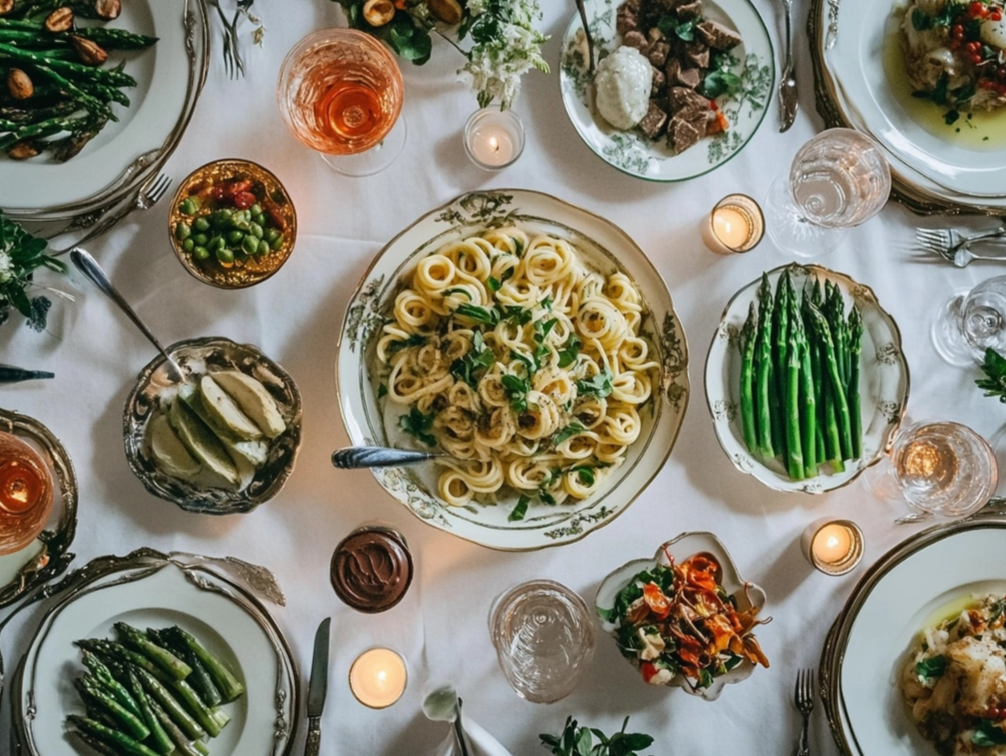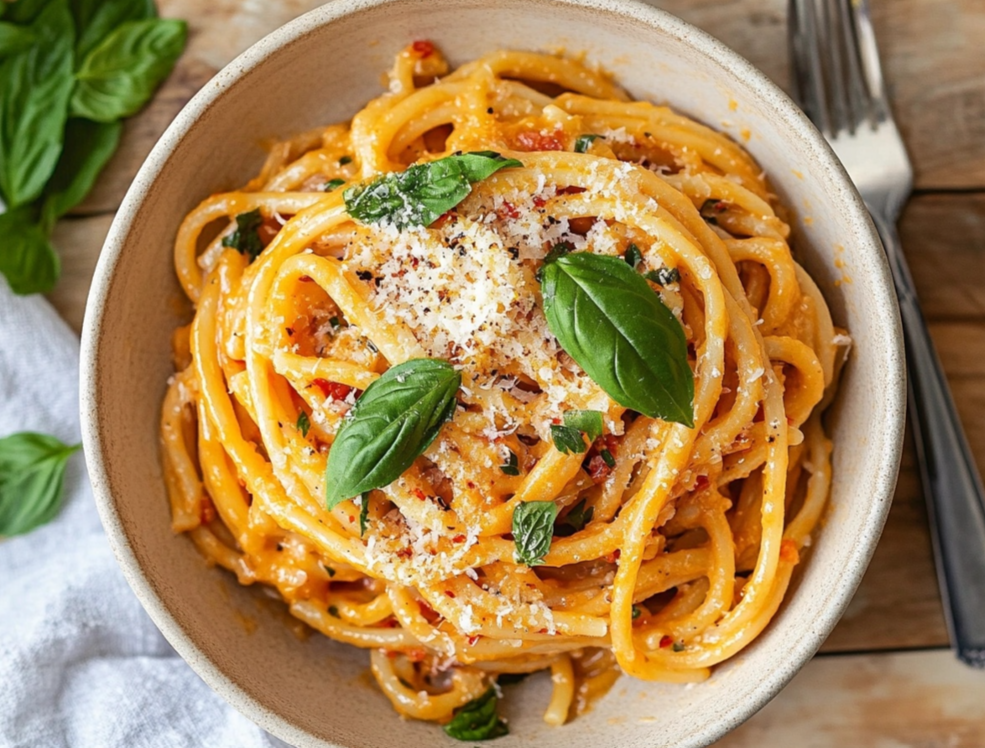Introduction to Zucchini Pasta
Enjoy the fresh flavors of zucchini pasta, a nutritious and tasty alternative to traditional noodles. This recipe is perfect for those seeking a low-carb and gluten-free option.
What Is Zucchini Pasta?
Zucchini pasta is a versatile dish that uses spiralized zucchini as a substitute for traditional pasta. Zucchini pasta offers a lighter and healthier alternative while maintaining the satisfying texture of regular noodles. Additionally, it can be paired with a variety of sauces and toppings to suit different tastes and dietary preferences.
Why Choose Zucchini Pasta?
Opting for zucchini pasta provides numerous benefits. Zucchini pasta is low in calories and carbohydrates, making it an excellent choice for weight management and those following ketogenic or gluten-free diets. Moreover, it is rich in vitamins, minerals, and antioxidants, contributing to overall health. Consequently, this dish serves as a nutritious and delicious alternative to traditional pasta, appealing to health-conscious individuals and food enthusiasts alike.
Health Benefits of Zucchini Pasta
Incorporating zucchini pasta into your diet offers a range of health benefits, making it a smart and flavorful choice for maintaining well-being.
Nutritional Value
Zucchini pasta is packed with essential nutrients. Zucchini is a low-calorie vegetable rich in vitamins A and C, potassium, and dietary fiber. It also contains antioxidants that help protect the body from oxidative stress. Additionally, replacing traditional pasta with zucchini increases the intake of vitamins and minerals while reducing overall calorie and carbohydrate consumption. Consequently, zucchini pasta contributes to a balanced and nutrient-dense diet.
Weight Management
For those aiming to manage their weight, zucchini pasta is an excellent option. Zucchini is low in calories and high in water content, promoting satiety and reducing overall calorie intake. Moreover, the high fiber content aids in digestion and keeps you feeling full longer, preventing overeating. Consequently, zucchini pasta supports weight loss and maintenance goals while providing a satisfying meal.
Heart Health
Zucchini pasta benefits heart health due to its low cholesterol and sodium content. Zucchini contains potassium, which helps regulate blood pressure, reducing the risk of heart disease. Additionally, the absence of refined carbohydrates in zucchini pasta minimizes spikes in blood sugar levels, contributing to better cardiovascular health. Therefore, incorporating zucchini pasta into your meals can support a healthy heart.
Digestive Health
The high fiber content in zucchini pasta promotes healthy digestion. Fiber aids in maintaining regular bowel movements and prevents constipation. Furthermore, fiber-rich foods support a healthy gut microbiome, enhancing overall digestive health. Consequently, zucchini pasta is beneficial for maintaining a well-functioning digestive system.
How to Prepare Zucchini Pasta
Creating a delicious zucchini pasta dish is simple and requires only a few straightforward steps. Follow this comprehensive guide to craft the perfect and flavorful zucchini pasta.
Step-by-Step Cooking Instructions
1. Choose the Right Zucchini
Select fresh, firm zucchinis without any soft spots or blemishes. Choosing the right zucchini ensures a better texture and flavor in your pasta.
2. Spiralize the Zucchini
Use a spiralizer, julienne peeler, or mandoline slicer to create zucchini noodles (zoodles). Spiralizing the zucchini transforms it into a pasta-like shape, making it an ideal substitute for traditional noodles.
3. Salt the Zucchini
Place the zoodles in a colander and sprinkle them with salt. Let them sit for about 10-15 minutes to draw out excess moisture. Salting the zucchini helps prevent the pasta from becoming watery and enhances its texture.
4. Sauté or Steam the Zucchini Pasta
- Sautéing: Heat a tablespoon of olive oil in a large skillet over medium heat. Add the zoodles and sauté for 2-3 minutes until they are tender but still firm. Sautéing the zucchini pasta adds flavor and reduces moisture.
- Steaming: Place the zoodles in a steamer basket over boiling water and steam for 2-3 minutes until tender. Steaming the zucchini pasta is a healthier option that retains more nutrients.
5. Prepare the Sauce
While the zucchini pasta is cooking, prepare your desired sauce. Options include marinara, pesto, Alfredo, or a simple garlic and olive oil mixture. Preparing the sauce in advance ensures a smooth and efficient assembly of the dish.
6. Combine and Serve
Once the zucchini pasta is cooked, transfer it to a serving dish and toss it with the prepared sauce. Combining the pasta and sauce ensures that every strand is well-coated and flavorful. Garnish with fresh herbs, grated Parmesan cheese, or crushed red pepper flakes if desired. Garnishing enhances both the flavor and presentation of the dish.

7. Enjoy Immediately
Serve the zucchini pasta immediately to enjoy its best texture and flavor. Serving immediately prevents the pasta from becoming soggy and maintains its fresh taste.
Tips for Perfect Zucchini Pasta
- Use Fresh Zucchini: Fresh zucchini yields the best texture and flavor.
- Don’t Overcook: Cook the zoodles just until tender to prevent them from becoming mushy.
- Season Well: Proper seasoning enhances the overall taste of the dish.
- Customize Your Sauce: Experiment with different sauces to keep the dish exciting and varied.
- Serve Fresh: Zucchini pasta is best enjoyed fresh or shortly after preparation.
Variations and Enhancements for Zucchini Pasta
Zucchini pasta is incredibly versatile and can be customized to cater to different tastes and dietary preferences. Here are some popular variations to inspire your culinary creativity.
Creamy Avocado Zucchini Pasta
Incorporate avocado into your sauce for a creamy and healthy twist. Blend avocado with garlic, lemon juice, and olive oil to create a rich and smooth sauce. Creamy avocado zucchini pasta adds healthy fats and a delightful texture, making the dish both nutritious and satisfying.
Garlic Butter Zucchini Pasta
Enhance your dish by adding garlic butter for a rich and savory flavor. Sauté minced garlic in melted butter and toss it with the zoodles. Garlic butter Z. pasta offers a simple yet delicious flavor profile that pairs well with a variety of toppings.
Spicy Zucchini Pasta
Add a kick to your pasta by incorporating red pepper flakes, sriracha, or chili oil. Spicy zucchini pasta introduces bold and invigorating flavors, making the dish more exciting and dynamic.
Pesto Zucchini Pasta
Mix fresh basil pesto with the zoodles for an herby and vibrant dish. Pesto zucchini pasta combines the fresh flavors of basil, pine nuts, and Parmesan cheese, creating a fragrant and flavorful meal.
Mediterranean Zucchini Pasta
Add sun-dried tomatoes, olives, and feta cheese to your zucchini pasta for a Mediterranean-inspired twist. Mediterranean zucchini pasta offers a rich and savory flavor profile, perfect for those who enjoy bold and robust tastes.
Lemon Garlic Zucchini Pasta
Incorporate lemon zest and juice along with garlic for a bright and refreshing flavor. Lemon garlic zucchini pasta adds a zesty and tangy dimension to the dish, enhancing its overall taste.
Zucchini Alfredo Pasta
Create a creamy Alfredo sauce using Greek yogurt or cashew cream for a dairy-free option. Zucchini Alfredo pasta offers a rich and indulgent sauce while maintaining the health benefits of zucchini.
Vegan Zucchini Pasta
Use vegan pesto or a dairy-free sauce to make the dish completely plant-based. Vegan zucchini pasta caters to those following a plant-based diet without compromising on flavor or texture.
Pairing Zucchini Pasta with Other Dishes
Creating a balanced and satisfying meal involves pairing zucchini pasta with complementary dishes. Here are some excellent pairings to enhance your dining experience.
Appetizer Pairings
- Bruschetta: Fresh tomato and basil bruschetta adds a vibrant and tangy contrast.
- Caprese Salad: Slices of fresh mozzarella, tomatoes, and basil drizzled with balsamic glaze complement the pasta.
- Garlic Bread: Warm garlic bread offers a satisfying crunch and savory flavor that pairs well with zucchini pasta.
- Stuffed Mushrooms: Savory stuffed mushrooms provide a delightful contrast in texture and flavor.
- Greek Salad: A crisp Greek salad with cucumbers, tomatoes, olives, and feta enhances the meal’s freshness.
Main Course Pairings
- Grilled Chicken: Tender grilled chicken breast pairs beautifully with the fresh flavors of zucchini pasta.
- Baked Salmon: Rich and flaky baked salmon complements the lightness of the pasta.
- Steak: Juicy steak adds a hearty and satisfying element to the meal.
- Roasted Vegetables: A medley of roasted vegetables enhances the meal with additional flavors and nutrients.
- Shrimp Scampi: Succulent shrimp in a garlic butter sauce pairs excellently with zucchini pasta.
Side Dish Pairings
- Caesar Salad: A classic Caesar salad provides a crisp and creamy side that balances the pasta.
- Roasted Potatoes: Crispy roasted potatoes add a comforting and hearty element to the meal.
- Steamed Asparagus: Lightly steamed asparagus offers a fresh and elegant side dish.
- Buttered Noodles: Simple buttered noodles provide a versatile and easy side option.
- Quinoa Pilaf: A nutritious quinoa pilaf complements the pasta with added protein and texture.
Dessert Pairings
- No-Bake Cheesecake Cups: Creamy and easy to prepare, these cheesecake cups make a perfect sweet ending.
- Fruit Tart: A fresh and tangy fruit tart offers a sweet and refreshing finish to the meal.
- Chocolate Mousse: A rich chocolate mousse provides a decadent and satisfying ending.
- Baklava: This rich and nutty pastry offers a decadent dessert option.
- Greek Yogurt with Honey and Nuts: A simple and healthy dessert that complements the meal without being too heavy.
Beverage Pairings
- White Wine: A crisp white wine like Sauvignon Blanc pairs well with the pasta’s fresh flavors.
- Red Wine: A light red wine such as Pinot Noir complements the heartiness of the pasta.
- Sparkling Water: Keeps the meal light and refreshing without overpowering flavors.
- Iced Tea: A glass of unsweetened iced tea offers a cool and refreshing beverage option.
- Lemonade: Fresh lemonade adds a sweet and tangy complement to the meal.
Complementary Dishes from Our Website
For a complete meal, consider adding No-Bake Cheesecake Cups for dessert or Bacon and Sausage for an extra savory component to your meal.
Sustainability and Zucchini Pasta
In today’s environmentally conscious world, sustainability in food choices is increasingly important. Therefore, zucchini pasta can be made more sustainable with mindful ingredient choices and preparation methods. Consequently, adopting sustainable practices not only benefits your health but also the planet.
Choosing Sustainable Ingredients
- Organic Zucchini: Opt for organic zucchini to support sustainable farming practices and reduce pesticide use.
- Local Produce: Purchase zucchini from local farmers to reduce carbon footprint and support the local economy.
- Seasonal Vegetables: Use zucchini that is in season to ensure freshness and minimize environmental impact.
- Eco-Friendly Packaging: Choose ingredients with minimal or recyclable packaging to lessen environmental impact.
- Sustainably Sourced Olive Oil: Select olive oil brands that use sustainable harvesting and production methods.
Reducing Food Waste
- Portion Control: Serve appropriate portions to minimize leftovers and reduce waste.
- Creative Repurposing: Use leftover zucchini pasta in salads, wraps, or as a topping for baked dishes.
- Proper Storage: Store any leftovers properly to extend their shelf life and maintain quality.
- Composting: Compost any vegetable scraps to reduce landfill waste and enrich your garden soil.
Eco-Friendly Cooking Practices
- Energy Efficiency: Use energy-efficient appliances and cooking methods to reduce energy consumption.
- Minimal Waste: Utilize all parts of the vegetables, such as using zucchini scraps in broths or smoothies.
- Reusable Containers: Store your zucchini pasta in reusable containers to minimize single-use packaging waste.
Storing and Preserving Zucchini Pasta
Proper storage ensures that your zucchini pasta remains fresh and delicious for future meals. Therefore, follow these guidelines to maintain the quality and safety of your dish.
Refrigeration Tips
- Airtight Containers: Store the zucchini pasta in airtight containers to prevent it from drying out or absorbing odors from other foods. Utilizing airtight containers is essential in maintaining the integrity and flavor of your pasta. These containers create a sealed environment that preserves moisture and prevents the transfer of unwanted aromas from other items in the refrigerator.
- Cool Before Storing: Allow the pasta to cool to room temperature before refrigerating to maintain its texture. Allowing the pasta to cool ensures that condensation does not form inside the storage container, which can lead to sogginess and degrade the overall quality of the dish.
- Consume Within 3 Days: For the best flavor and safety, enjoy the zucchini pasta within three days of preparation. Consuming within three days guarantees that the dish retains its optimal taste and nutritional value while minimizing the risk of bacterial growth and spoilage.
Freezing Methods
While zucchini pasta is best enjoyed fresh, it can be frozen for longer storage with some adjustments:
- Portioning: Divide the pasta into individual portions before freezing. This allows for easy thawing and reheating based on your needs.
- Use Freezer-Safe Containers: Store the portions in airtight, freezer-safe containers or heavy-duty freezer bags to prevent freezer burn and preserve freshness.
- Labeling: Clearly label each container with the date and contents for easy identification. This helps in keeping track of storage time and ensures you use the oldest batches first.
- Use Within 2 Months: For optimal quality, consume the frozen pasta within two months. Although it remains safe beyond this period, the texture and flavor may begin to deteriorate.
Thawing Techniques
- Refrigerator Thawing: Transfer the frozen zucchini pasta to the refrigerator overnight to thaw slowly. This method preserves the texture and flavor without compromising safety.
- Microwave Thawing: Use the microwave’s defrost setting, stirring occasionally to ensure even thawing. Microwave thawing is quicker but requires careful monitoring to prevent overheating.
- Avoid Refreezing: Once thawed, avoid refreezing to maintain quality and safety. Refreezing can cause the pasta to become mushy and lose its fresh taste.
Reheating Tips
When reheating zucchini pasta, do so gently to preserve its texture:
- Stovetop: Heat the pasta over medium-low heat, stirring occasionally until warmed through.
- Oven: Pour the pasta into an oven-safe dish, cover, and bake at 350°F (175°C) until heated.
- Microwave: Heat in the microwave in short intervals, stirring in between, until the pasta is evenly warmed.
Food Safety Practices
- Avoid Cross-Contamination: Use separate utensils and cutting boards for raw and cooked ingredients to prevent the spread of bacteria.
- Proper Cooling: Cool any leftover pasta quickly by spreading it out in shallow containers before refrigerating.
- Check for Spoilage: Discard any pasta that shows signs of mold, off-smells, or unusual textures. Safe food practices are essential to prevent foodborne illnesses.
Frequently Asked Questions
Is zucchini pasta healthy?
Yes, zucchini pasta is a healthy alternative to traditional pasta. Zucchini pasta is low in calories and carbohydrates, making it suitable for weight management and those following ketogenic or gluten-free diets. Additionally, it is rich in vitamins, minerals, and antioxidants, contributing to overall health. By replacing refined grains with nutrient-dense zucchini, this dish supports a balanced and nutritious diet.
How do you make zucchini pasta not watery?
To prevent zucchini pasta from becoming watery, follow these tips:
- Salt the Zucchini: Sprinkle salt over the spiralized zucchini and let it sit for 10-15 minutes to draw out excess moisture.
- Pat Dry: After salting, use paper towels to pat the zoodles dry before cooking.
- Cook Properly: Sauté or steam the zucchini until just tender to minimize moisture retention.
- Serve Immediately: Serve the pasta as soon as it’s cooked to prevent it from releasing more water.
- Use a Thick Sauce: Pair with a thick sauce that can absorb any excess moisture, enhancing the overall texture of the dish.
Why is boiling not recommended for zucchini?
Boiling zucchini is not recommended because it can lead to overcooking, resulting in mushy and bland-tasting pasta. Boiling zucchini causes it to lose its vibrant color and essential nutrients, diminishing the overall quality of the dish. Additionally, boiled zucchini releases more water, making the pasta watery and unappetizing. Instead, opt for sautéing, steaming, or roasting to preserve the texture and flavor of the zucchini.
How do you cut zucchini for pasta?
To cut zucchini for zucchini pasta, follow these steps:
- Wash the Zucchini: Rinse the zucchini under cold water to remove any dirt or debris.
- Trim the Ends: Cut off both ends of the zucchini using a sharp knife.
- Spiralize: Use a spiralizer, julienne peeler, or mandoline slicer to create zucchini noodles (zoodles).
- Uniform Sizing: Ensure the zoodles are of uniform thickness for even cooking.
- Optional Cutting: For different shapes, you can slice the zucchini into thin strips or ribbons using a vegetable peeler.
Properly cutting the zucchini ensures a consistent texture and appearance in your pasta dish, enhancing both the visual appeal and the eating experience.
Conclusion
Zucchini pasta is a versatile and nutritious dish that offers a healthy alternative to traditional noodles. This recipe not only provides a low-calorie and low-carb option but also incorporates a variety of fresh vegetables and flavors, making it a delightful meal for any occasion. Whether you’re seeking to manage your weight, follow a gluten-free diet, or simply enjoy a delicious and healthy meal, zucchini pasta is sure to satisfy your taste buds and nourish your body. By following our comprehensive guide and experimenting with different sauces and toppings, you can master this delightful dish and make it a staple in your culinary repertoire. Therefore, embrace the fresh flavors and health benefits of Z. pasta as a delicious and wholesome addition to your meal planning.

